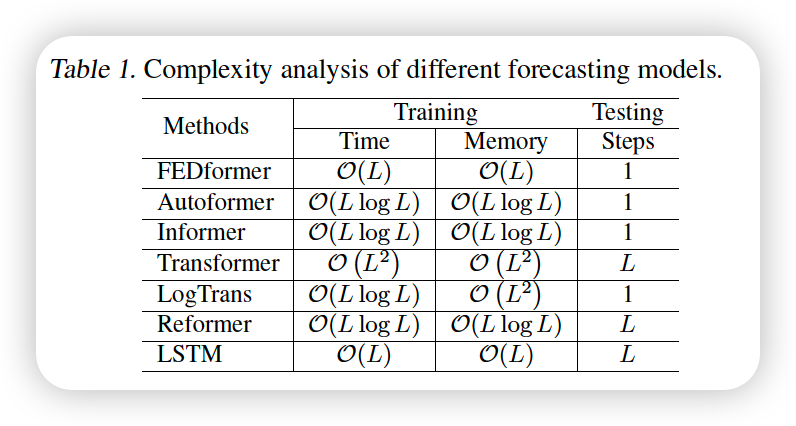FEDformer : Frequency Enhanced Decomposed Transformer for Long-term TS Forecasting (2022)
Contents
- Abstract
- Introduction
- Compact Representation of TS in Frequency Domain
- Model Stucture
- FEDformer Framework
- Fourier Enhanced Structure
- Wavelet Enhanced Structure
- Mixture of Experts for ST decomposition
- Complexity Analysis
0. Abstract
Cons of Transformer
- (1) computationally expensive
- (2) unable to capture GLOBAL view
Proposal :
- TRANSFORMER with seasonal-trend DECOMPOSITION
- Decomposition method :
- captures global profile of TS
- Transformer :
- captures more detailed structure
- Decomposition method :
- for LONG-term prediction …
- most TS tend to have a sparse representation in well-known basis, such as Fourier Transform
\(\rightarrow\) propose FEDformer
1. Introduction
LONG-term TS forecasting
- RNN :
- cons : problem of gradient vanishing/exploding
- Transformer :
- pros : able to capture long-term dependencies
- cons : tend to fail in capturing the OVERALL(=GLOBAL) characteristics of TS
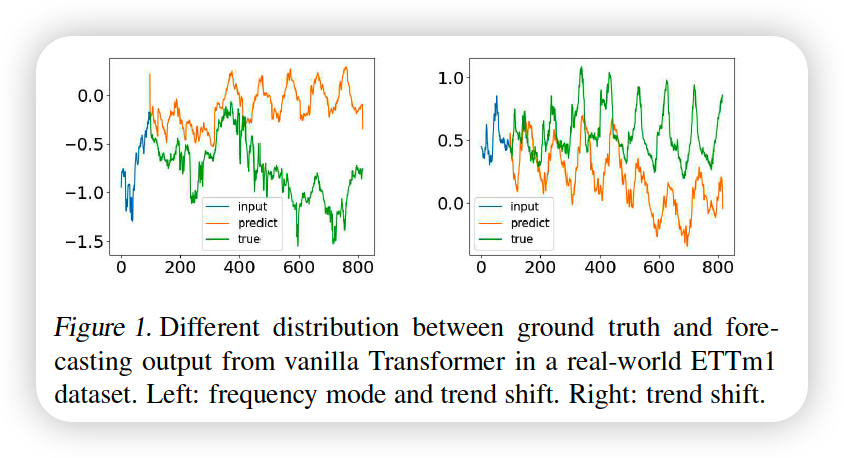
Prediction for each timestep is made individually & independentlly
- likely to fail to capture the global property/statistics of TS as a whole
- to solve this…propose FEDformer
- IDEA 1) incorporate S-T decomposition
- IDEA 2) combine Fourier Analysis with Transformer
Key quetsion :
-
which subset of frequency components should be used by Fourier Analysis?
-
(common wisdom)
- keep LOW frequency component
- throw away HIGH frequency component
\(\rightarrow\) NOT APPROPRIATE!
-
solve this, by effectively exploiting the fact that
TS tend to have SPARSE representations on a basis, like Fourier basis
\(\rightarrow\) randomly select frequency components!
Contribution
- propose FEDformer
-
propose Fourier enhanced blocks & Wavelet enhanced blocks
-
by randomly selecting a fixed number of Fourier components,
achieve linear computational complexity & memory cost
2. Compact Reprsentation of TS in Frequency domain
TS : can be modeled in
- (1) TIME domain
- (2) FREQUENCY domain
\(\rightarrow\) this algorithm : frequency-domain operation with NN
keep compact representation of TS,
using a small number of selected Foureir components ( more efficient! )
Notation
(before Fourier Transform)
- \(m\) time series : \(X_{1}(t), \ldots, X_{m}(t)\)
(after Fourier Transform)
-
\(X_{i}(t)\) becomes \(a_{i}=\left(a_{i, 1}, \ldots, a_{i, d}\right)^{\top} \in \mathbb{R}^{d}\)
-
\(A=\left(a_{1}, a_{2}, \ldots, a_{m}\right)^{\top} \in \mathbb{R}^{m \times d}\).
- row : each TS ( \(m\) )
- col : each Fourier Component ( \(d\) )
need to select a subset of Fourier components
- select \(s\) out of \(d\) ( Uniformly at random )
- randomly selected components :
- \(i_{1}<i_{2}< ... < i_{s}\).
Selected components :
- \(i_{1}<i_{2}< ... < i_{s}\).
- matrix \(S \in\{0,1\}^{s \times d}\)
- \(S_{i, k}=1\) if \(i=i_{k}\) and \(S_{i, k}=0\) otherwise.
Representation of MTS :
- \(A^{\prime}=A S^{\top} \in \mathbb{R}^{m \times s}\).
3. Model Structure
introduce 3 parts
- (1) overall structure of FEDformer
- (2) 2 subversion strutures for signal process
- (2-1) Fourier basis
- (2-2) Wavlet basis
- (3) mixture of experts mechanism for ST decomposition
3-1. FEDformer Framework
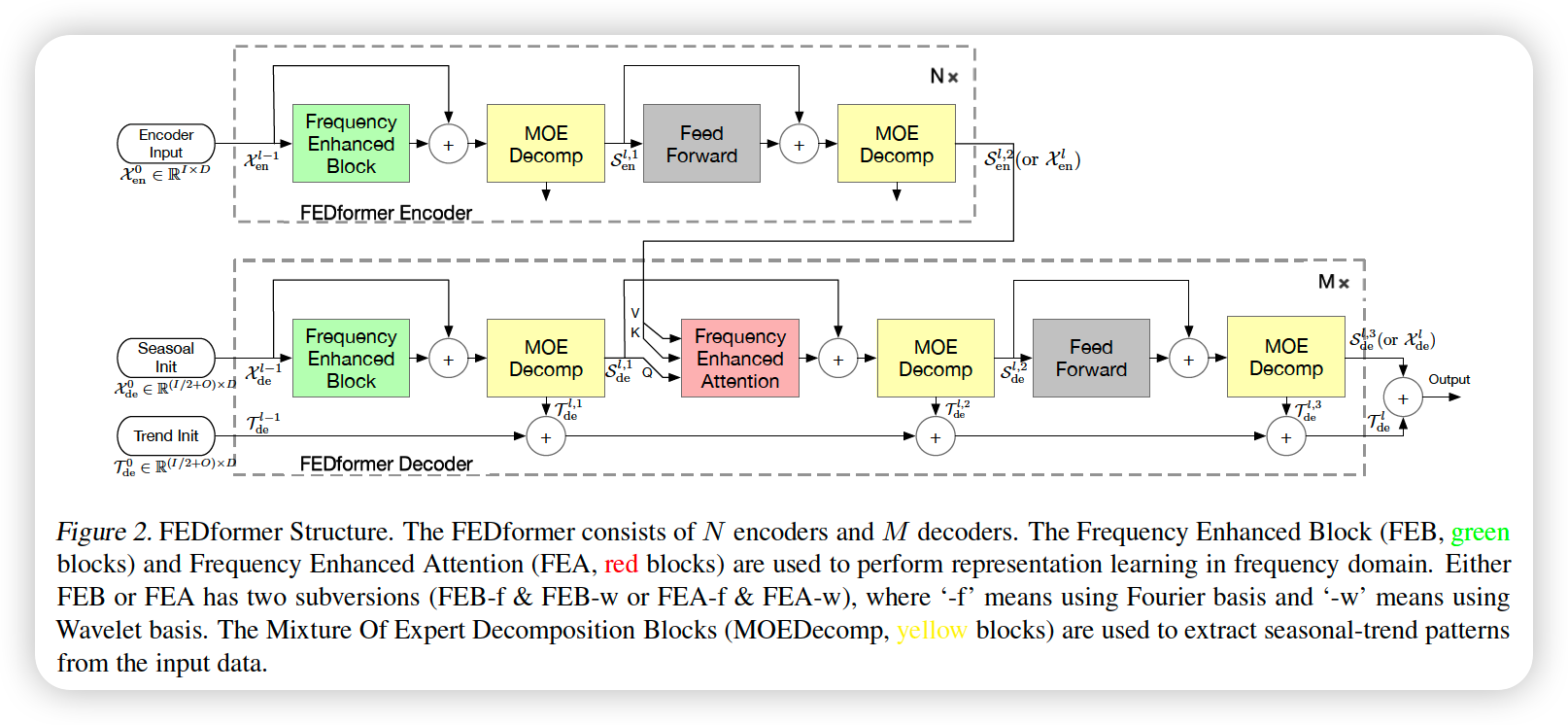
Notation
- input length = \(I\)
- output length = \(O\)
- hidden state of TS = \(D\)
- Input
- of Encoder : \(I \times D\) matrix
- of Decoder : \((I/2 + O) \times D\) matrix
FEDformer Structure
- renovate Transformer as a deep decomposition architecture
- includes..
- (1) FED ( Frequency Enhanced Block )
- (2) FEA ( Frequency Enhanced Attention )
- (3) MOEDcomp ( Mixture Of Experts Decomposition block )
a) Encoder

Encoder : multi-layer structure
( layer index : \(l \in\{1, \cdots, N\}\) )
-
\(\mathcal{X}_{\mathrm{en}}^{0} \in \mathbb{R}^{I \times D}\) : embedded historical TS
-
\(\mathcal{X}_{\mathrm{en}}^{l}=\operatorname{Encoder}\left(\mathcal{X}_{\text {en }}^{l-1}\right)\).
Encoder details :
\(\begin{aligned} \mathcal{S}_{\mathrm{en},-}^{l, 1} &=\operatorname{MOEDecomp}\left(\operatorname{FEB}\left(\mathcal{X}_{\mathrm{en}}^{l-1}\right)+\mathcal{X}_{\mathrm{en}}^{l-1}\right) \\ \mathcal{S}_{\mathrm{en}}^{l, 2}, &=\operatorname{MOEDecomp}\left(\text { FeedForward }\left(\mathcal{S}_{\mathrm{en}}^{l, 1}\right)+\mathcal{S}_{\mathrm{en}}^{l, 1}\right) \\ \mathcal{X}_{\mathrm{en}}^{l} &=\mathcal{S}_{\mathrm{en}}^{l, 2} \end{aligned}\).
- \(\mathcal{S}_{\mathrm{en}}^{l, i}, i \in\{1,2\}\) : seasonal component after the \(i\)-th decomposition block in the \(l\)-th layer
b) Decoder

Decoder : multi-layer structure
( layer index : \(l \in\{1, \cdots, M\}\) )
- \(\mathcal{X}_{\mathrm{de}}^{l}, \mathcal{T}_{\mathrm{de}}^{l}=\operatorname{Decoder}\left(\mathcal{X}_{\mathrm{de}}^{l-1}, \mathcal{T}_{\mathrm{de}}^{l-1}\right)\).
Decoder details :
\(\begin{aligned} \mathcal{S}_{\mathrm{de}}^{l, 1}, \mathcal{T}_{\mathrm{de}}^{l, 1} &=\operatorname{MOEDecomp}\left(\mathrm{FEB}\left(\mathcal{X}_{\mathrm{de}}^{l-1}\right)+\mathcal{X}_{\mathrm{de}}^{l-1}\right) \\ \mathcal{S}_{\mathrm{de}}^{l, 2}, \mathcal{T}_{\mathrm{de}}^{l, 2} &=\operatorname{MOEDecomp}\left(\operatorname{FEA}\left(\mathcal{S}_{\mathrm{de}}^{l, 1}, \mathcal{X}_{\mathrm{en}}^{N}\right)+\mathcal{S}_{\mathrm{de}}^{l, 1}\right) \\ \mathcal{S}_{\mathrm{de}}^{l, 3}, \mathcal{T}_{\mathrm{de}}^{l, 3} &=\operatorname{MOEDecomp}\left(\text { FeedForward }\left(\mathcal{S}_{\mathrm{de}}^{l, 2}\right)+\mathcal{S}_{\mathrm{de}}^{l, 2}\right) \\ \mathcal{X}_{\mathrm{de}}^{l} &=\mathcal{S}_{\mathrm{de}}^{l, 3} \\ \mathcal{T}_{\mathrm{de}}^{l} &=\mathcal{T}_{\mathrm{de}}^{l-1}+\mathcal{W}_{l, 1} \cdot \mathcal{T}_{\mathrm{de}}^{l, 1}+\mathcal{W}_{l, 2} \cdot \mathcal{T}_{\mathrm{de}}^{l, 2}+\mathcal{W}_{l, 3} \cdot \mathcal{T}_{\mathrm{de}}^{l, 3} \end{aligned}\).
- \(\mathcal{S}_{\mathrm{de}}^{l, i}, \mathcal{T}_{\mathrm{de}}^{l, i}, i \in\{1,2,3\}\) : represent the seasonal & trend component, after the \(i\)-th decomposition block in the \(l\)-th layer
c) Final prediction
- sum of 2 refined decomposed components : \(\mathcal{W}_{\mathcal{S}} \cdot \mathcal{X}_{\mathrm{de}}^{M}+\mathcal{T}_{\mathrm{de}}^{M}\)
- \(\mathcal{W}_{\mathcal{S}}\) : project seasonal component \(\mathcal{X}_{\mathrm{de}}^{M}\) to the target dim
3-2. Fourier Enhanced Structure
a) DFT ( Discrete Fourier Transform )
Notation
- \(\mathcal{F}\) : Fourier Transform
- \(\mathcal{F}^{-1}\) : Inverse Fourier Transform
- sequence of real numbers \(x_{n}\) ( TIME domain )
- where \(n=1,2 \ldots N\).
DFT : \(X_{l}=\sum_{n=0}^{N-1} x_{n} e^{-i \omega l n}\)
( where \(l=1,2 \ldots L\) )
- \(i\) : imaginary unit
- \(X_{l}\) : sequence of complex numbers in frequency domain
iDFT : \(x_{n}=\sum_{l=0}^{L-1} X_{l} e^{i \omega l n}\)
Complexity :
-
DFT : \(O\left(N^{2}\right)\)
-
FFT : \(O(N \log N)\)
-
random subset of Fourier basis : \(O(N)\)
( + mode index before DFT and reverse DFT operations )
b) FEB-f ( Frequency Enhanced Block ( with Fourier Transform ) )
both used in Encoder & Decoder
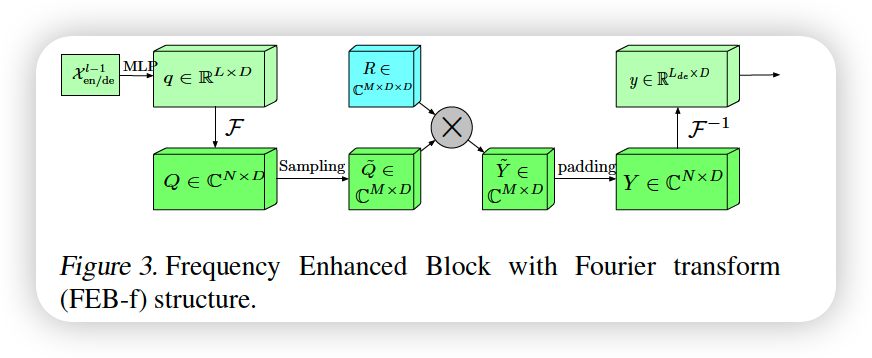
Process
- step 1) linear projected : \(\boldsymbol{q}=\boldsymbol{x} \cdot \boldsymbol{w}\)
- where \(\boldsymbol{w} \in \mathbb{R}^{D \times D}\)
- matrix notation : \(Q \in \mathbb{C}^{N \times D}\)
- step 2) convert TIME \(\rightarrow\) FREQUENCY domain : \(\boldsymbol{Q} = \mathcal{F}(\boldsymbol{q})\)
- step 3) select \(M\) Modes ( uniform randomly ) : \(\tilde{\boldsymbol{Q}}\)
- step 4) element-wise product with parameterized kernel : \(\boldsymbol{Y}=\boldsymbol{\tilde{Q}} \odot \boldsymbol{C}\)
- step 5) padding : \(\operatorname{Padding}(\tilde{\boldsymbol{Q}} \odot \boldsymbol{R})\)
- step 6) inverse transform : \(\mathrm{FEB}-\mathrm{f}(\boldsymbol{q})=\mathcal{F}^{-1}(\operatorname{Padding}(\tilde{\boldsymbol{Q}} \odot \boldsymbol{R}))\)
- back to TIME domain
c) FEA-f ( Frequency Enhanced Attention ( with Fourier Transform ) )
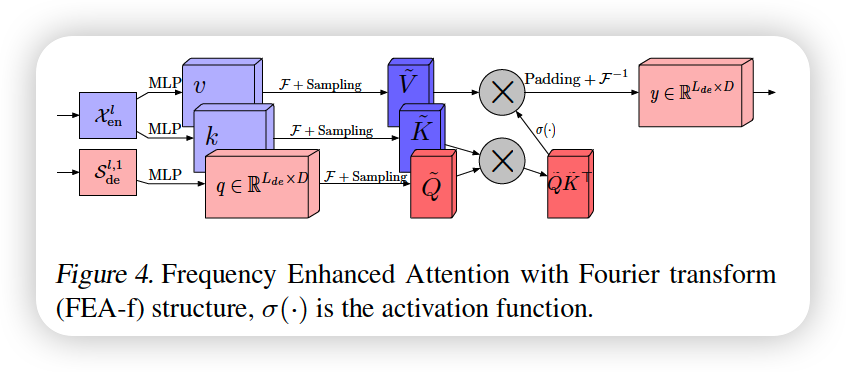
Expression of the canonical transformer
- \(\boldsymbol{q} \in \mathbb{R}^{L \times D}, \boldsymbol{k} \in \mathbb{R}^{L \times D}, \boldsymbol{v} \in \mathbb{R}^{L \times D}\).
Cross-attention
- Q come from decoder : \(\boldsymbol{q}=\boldsymbol{x}_{e n} \cdot \boldsymbol{w}_{q}\)
- where \(\boldsymbol{w}_{q} \in \mathbb{R}^{D \times D}\)
- K & V from encoder : \(\boldsymbol{k}=\boldsymbol{x}_{d e} \cdot \boldsymbol{w}_{k}\) and \(\boldsymbol{v}=\boldsymbol{x}_{d e} \cdot \boldsymbol{w}_{v}\)
- where \(\boldsymbol{w}_{k}, \boldsymbol{w}_{v} \in \mathbb{R}^{D \times D}\)
- attention :
- \(\operatorname{Atten}(\boldsymbol{q}, \boldsymbol{k}, \boldsymbol{v})=\operatorname{Softmax}\left(\frac{\boldsymbol{q} \boldsymbol{k}^{\top}}{\sqrt{d_{q}}}\right) \boldsymbol{v}\).
in FEA-f, convert Q,K,V with FOURIER TRANSFORM
( with selected \(M\) modes )
- selected version after Fourier Transform :
- \[\tilde{\boldsymbol{Q}} \in \mathbb{C}^{M \times D}, \boldsymbol{K} \in \mathbb{C}^{M \times D}, \tilde{\boldsymbol{V}} \in \mathbb{C}^{M \times D}\]
- FEA-f :
- \(\tilde{\boldsymbol{Q}} =\operatorname{Select}(\mathcal{F}(\boldsymbol{q}))\).
- \(\tilde{\boldsymbol{K}}=\operatorname{Select}(\mathcal{F}(\boldsymbol{k}))\).
- \(\tilde{\boldsymbol{V}}=\operatorname{Select}(\mathcal{F}(\boldsymbol{v}))\).
- \(\mathrm{FEA}-\mathrm{f}(\boldsymbol{q}, \boldsymbol{k}, \boldsymbol{v})=\mathcal{F}^{-1}\left(\operatorname{Padding}\left(\sigma\left(\tilde{\boldsymbol{Q}} \cdot \tilde{\boldsymbol{K}}^{\top}\right) \cdot \tilde{\boldsymbol{V}}\right)\right)\).
- use softmax/tanh for activation function
3-3. Wavelet Enhanced Structure
a) DWT ( Discrete Wavelet Transform )
b) FEB-w ( Frequency Enhanced Block ( with Wavelet Transform ) )
c) FEA-w ( Frequency Enhanced Attention ( with Wavelet Transform ) )
3-4. Mixture of Experts for ST decomposition
extracting trend can be hard with FIXED window average pooling
\(\rightarrow\) use MOEDecomp ( Mixture of Experts Decomposition block )
contains a set of average filters with different sizes,
to extract multiple trend components from the input signal
\(\mathbf{X}_{\text {trend }}=\operatorname{Softmax}(L(x)) *(F(x))\).
- \(F(\cdot)\) : set of average pooling filters
- \(\operatorname{Softmax}(L(x))\) : weights for mixing these extracted trends
3-5. Complexity Analysis
